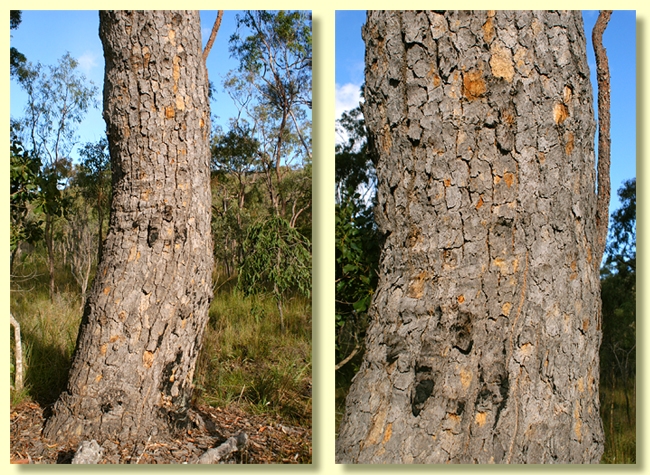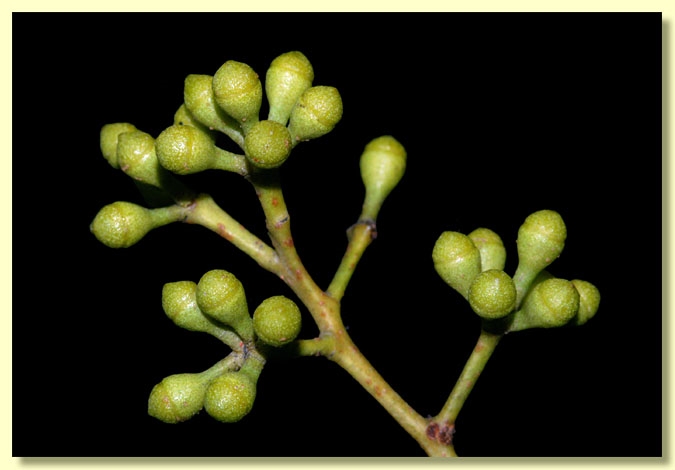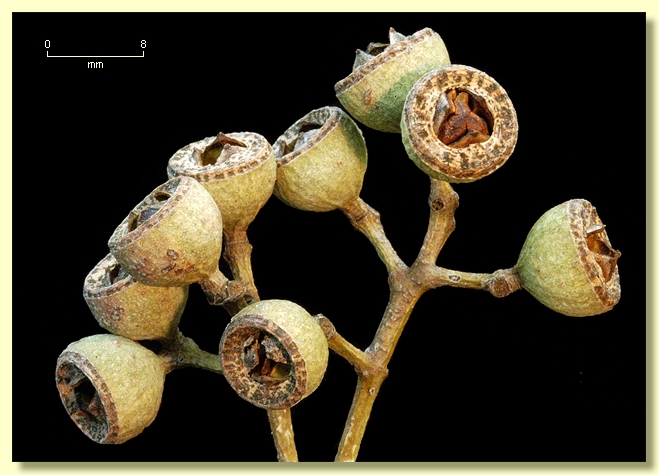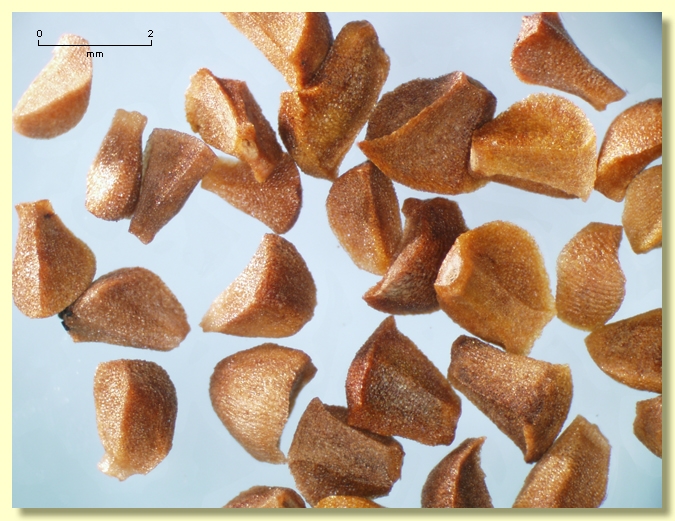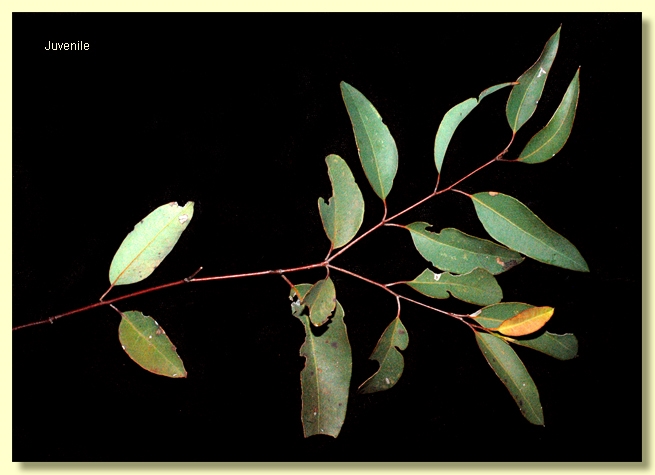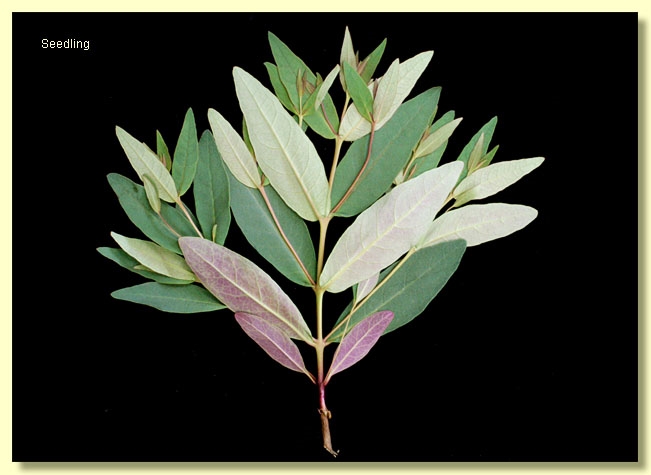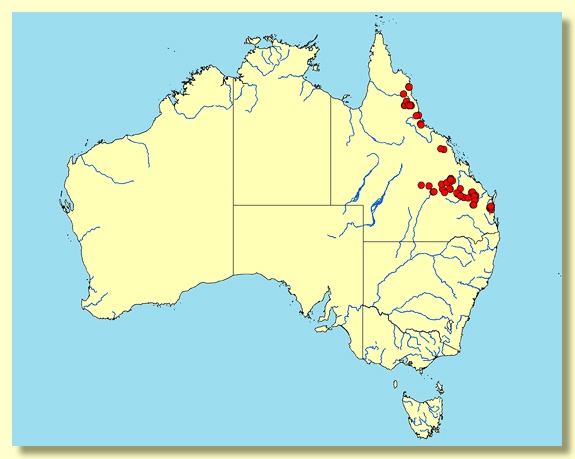Euclid - Online edition
Eucalyptus cloeziana
Eucalyptus | Idiogenes
Tree occasionally to 55 m tall but more commonly 10–25 m tall. Forming a lignotuber.
Bark rough, grey-brown to orange-brown to yellowish grey, over most of or whole trunk and sometimes extending to larger branches down to 20 cm diameter, smooth above. Rough bark thick, soft and flaky to fibrous becoming coarsely tessellated on older trunks; smooth bark white to grey-brown to orange.
Branchlets: lack pith glands; non-glaucous.
Juvenile growth (coppice or field seedlings to 50 cm): stems rounded in cross-section, feel smooth but have microscopic hairs/warts; juvenile leaves alternate, petiolate, ovate, 4.5–10(15) cm long, 2–5(7) cm wide, base tapering, apex pointed, discolorous, green.
Adult leaves alternate, petiole 0.8–2.2 cm long; blade lanceolate to falcate or sometimes ovate, 6–14.5 cm long, 0.9–3.2 cm wide, base tapering to petiole or oblique, margin entire, apex pointed with a drip-tip, conspicuously discolorous, dull to only slightly glossy, darker green above, side-veins greater than 45° to midrib, moderately to densely reticulate, intramarginal vein present, oil glands scattered, not clearly visible but probably intersectional.
Inflorescence axillary compound, peduncles round to angular, 0.2–1.3 cm long, buds 7 per umbel, pedicels 0.1–0.5 cm long. Mature buds globular to obovoid or ovoid (0.4–0.6 cm long, 0.3–0.4 cm wide), microscopic sepals present in young buds but deciduous very early in development, operculum scar absent, inner (petaline) operculum bluntly conical to rounded, occasionally with short thick beak, petal margins sometimes visible near apex of operculum only, stamens regularly inflexed, anthers ± cuboid, versatile, dorsifixed, dehiscing by separate longitudinal slits or the slits confluent, style long, stigma tapered, locules 3(4) each with four vertical ovule rows; flowers white.
Fruit sessile or pedicellate (pedicels to 0.2 cm long), truncate-globose to hemispherical, 0.4–0.7(0.9) cm long, 0.6–1.1 cm wide, disc raised obliquely or flat and level with rim, rarely descending and not visible, valves 3(4), at disc level or exserted.
Seeds pale to mid brown, 1.8–3 mm long, obliquely pyramidal to ± cuboid, dorsal surface smooth, hilum terminal.
Cultivated seedlings (measured at ca node 10): cotyledons large, reniform, green above, purple under; stems ± rounded in cross-section, feel smooth but a few rudimentary warts present; leaves sessile, opposite, elliptical with stem-clasping to rounded bases for ca 4–12 nodes then becoming shortly petiolate, fully alternate at nodes ca 6-?13, ovate, 3.5–7 cm long, 1.5–3 cm wide, base rounded to tapering when leaves are alternate, margin entire, apex pointed, discolorous, dull, green above, discolorous, lower leaves purple beneath, a few rudimentary hairs/warts present on underside.
Flowering has been recorded in January and December.
A tall forest tree or shorter woodland tree, endemic to Queensland, widely distributed from Gympie and Mundubbera west through Monto, Biloela, Moura, Blackdown Tableland, Rolleston and further west to north of Tambo occurring on hills and ranges. North of this area there are disjunct occurrences west of Mackay, and further north again from Greenvale, Stannary Hills, Herberton, Maitland Downs and Helenvale, reaching the coast near Cardwell and on Hinchinbrook Island. In the Gympie and Cardwell areas Eucalyptus cloeziana is found on deeper more fertile soils and becomes a tall forest tree. In other areas on shallower, poorer soils derived from sandstone or granite it is a component of low open forest. E. cloeziana can be distinguished from all other species with which it grows by the combination of compound axillary inflorescence, buds in sevens, ± hemispherical fruit to 1.1 cm wide with conspicuous disc and valves, alternate discolorous crown leaves and thick flaky-fibrous to tessellated grey-brown to orange-brown to yellowish grey rough bark on most or all of the trunk to stems ca 20 cm diameter.
In the classification of Brooker (2000) Eucalyptus cloeziana has no close relatives, being placed in Eucalyptus subgenus Idiogenes Pryor & Johnson, having flaky rough bark, seedlings with emergent oil glands (more like warts), discolorous adult leaves, compound axillary inflorescences, buds with sepals (which are microscopic and very difficult to find even on young inflorescences), oblong anthers, ovules in 4 rows and cuboid (to pyramidal) seed with terminal hilum.
Extra note: specimen collected from Binjour Plateau, Gayndah, Qld, (Crisp 11383) from a tree with intermediate crown had glaucous ultimate branchlets, a feature of this species not seen elsewhere.
Eucalyptus cloeziana: after Francois Stanislas Cloez (1817–1883). Francois Cloez was a noted French analytical chemist interested in, among other things, the essential oils of the eucalypts.


